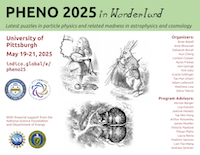Conveners
New Physics at Future Colliders: I
- Deepak Sathyan
Discovering that neutrinos have mass has left question regarding their origin. One possible model of their origin are Left-Right models, which add a SU(2) group with a right handed neutrino and a new heavy charged boson W'. Searches at the LHC for this heavy boson have not been successful, meaning that larger and more energetic colliders are needed. This analysis searches for the W' at 6.5 TeV...
We study the interactions between light axion-like particles (ALPs) and the Standard Model electroweak gauge bosons at future lepton colliders. In the long-lived ALP regime, mono-photon and mono-$Z$ production channels are exploited, while for ALPs with shorter lifetimes, non-resonant vector boson scattering processes are used. Our combined analysis shows that future lepton colliders can...
New electroweak states with masses below the TeV scale can still be discovered at the LHC. We show that motivated electroweak particles that are confined by a new gauge group could have masses as low as $100~{\rm GeV}$ and still be consistent with LHC searches. Additionally, we introduce a new search strategy to discover such particles at the high-luminosity LHC.
The COmpact DEtector for EXotics at LHCb (CODEX-b) is a particle physics detector dedicated to displaced decays of exotic long-lived particles (LLPs), compelling signatures of dark sectors Beyond the Standard Model, which arise in theories containing a hierarchy of scales and small parameters. The CODEX-b detector is a cube with 10m per side with two internal sections, planned to be installed...
We study the physics potentials of heavy QCD axions at 3/10 TeV muon colliders (MuC). These heavy QCD axions differ from typical ALPs as they solve the Strong CP puzzle, and their phenomenology is driven by the $aG\tilde G$ couplings. Different realizations of heavy QCD axions have different implications, and we show comprehensively how muon colliders can uniquely probe them with a huge...
A high-energy muon collider provides a wide variety of mechanisms for the production of new heavy particles. In this talk, I will first show how the PDFs for quarks, gluons and photons can be applied on muon collider, and then present production cross sections for a large variety of colored particles, including color triplet fermions and scalars and color sextet diquarks, leptoquarks,...
Higgs couplings are essential probes for physics beyond the Standard Model (BSM) since they can be modified by new physics, such as through the Higgs portal interaction $|H|^2\mathcal{O}$. These modifications influence Higgs interactions via dimension-6 operators of the form $ \left(\partial |H|^2\right)^2$ and $|H|^6$, which are generally expected to be of comparable size. This talk discusses...
The Electron-Ion Collider (EIC) will have the capability to collide various particle beams with large luminosities in a relatively clean environment, surrounded by a large angular coverage detector. Our analysis focuses on the EIC’s sensitivity to Axion-like particles (ALPs) that are created via photon fusion and promptly decay to photons. We explore this predominantly through coherent...

